Translations:
Other Pages:
CEC Training Modules
Akan Studies Site Map
Sociology for beginners
Contact
Kompan Adepa
Go to the People
Ghana Web
Women III; Cooking 1
by Phil Bartle, PhD
Cooking
There is a wide and varied range of soups and stews and several kinds of starch foods in the Akan diet. This essay is not complete, but is based on the few slides I have available.
At the school where I first taught, St. Peters, the bachelor teachers would get together on weekends and prepare soup and fufu, joking that men were better cooks than women, especially in making the preferred soups, groundnut or palm, to eat with fufu. Women, however, did most of the cooking.
Fufu
 |
The elite dish of the Kwawu is fufu (literally "white white") a special kind of starch food eaten with soup.
Originally, fufu was made of yams. With the economic pressure on farm land caused by the great cocoa migration, with destruction of farm land by the logging of huge protective trees, and with the spoiling of soil by tractors plowing too deeply and commercial fertilizer causing acidification then lateritization, a new source is used for fufu. Although yams are still used, most fufu is now made with a combination of plantain (cooking banana) and cassava. The cassava is too soft alone, and the plantain is too hard. Together they do well.
 |
 |
Pounding Fufu
First the yam (or combination of plantain and cassava) is boiled. Then a mortar and pestle are used to pound the fufu. A single person can make a small amount of fufu, pounding it with one hand and turning with another.
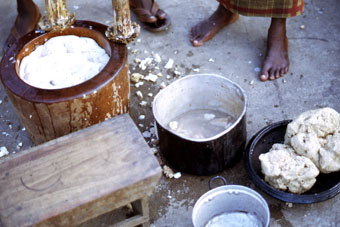 |
 |
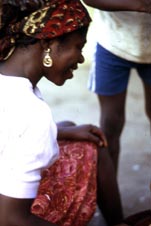 |
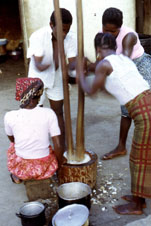 |
 |
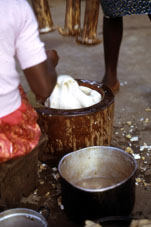 |
Pounding Fufu | Both boys and girls pound but usually women or girls turn it
When more fufu is needed, and more persons available, then one person sits next to the mortar, and one, two or three persons stand and pound the starch while the person sitting, usually a girl or woman, turns it. Wood carvers, usually men, make the mortars and pestles.
At commercial open air restaurants, called "chop bars," in Pidgin English, a woman trader (business owner) or her assistant often does the turning while hired men, usually from the North, do the pounding.
 |
Fufu Prepared
The starch changes its chemical composition because of the pounding; it agglutinates. It is not to be chewed or tasted. The taste comes from the soup with which it is eaten. Mouth sized bites are broken off by fingers of the right hand from the ball of fufu in the bowl, swished around in the soup, popped into the mouth and swallowed whole. Mmmm!
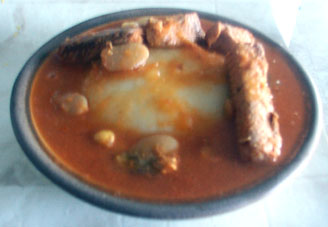 |
Fufu in Smoked Fish Nkrakra
Fufu is not supposed to be chewed. It is considered to already be chewed by the pounding and its chemical change of agglutination. Nor is it supposed to be particularly strong tasting. The taste should come from the soup. A small piece is cut or squeezed off from the ball by the index and king finger of the right hand, swished around in the soup, popped into the mouth, and swallowed like that. The meat can be chewed, and if it is particularly tough to chew it is more appreciated. When an important guest comes to the house, a child is sent to chase the oldest and toughest chicken, ie the most respected and senior, for the pot, the chase itself no doubt adding to the toughness of the meat. Older people, and those who are aficionados of Akan food, despise the commercial chickens that are grown in cages and have soft tasteless meat. In the vernacular, one does not eat (di) meat, but chews (wyie) it.
A popular starch based on imported rice is Omo Tu or Tue (rice balls) the size and shape of cannon balls. When the rice is cooked, it is allowed to become sticky so that it can be formed into balls. It is eaten in a manner similar to fufu, with soup. It is not pounded.
A meal of boiled tubers or roots is called ampesi. It is usually eaten with a stew, of which there are many varieties. The favorite tuber is bayere (king yam).
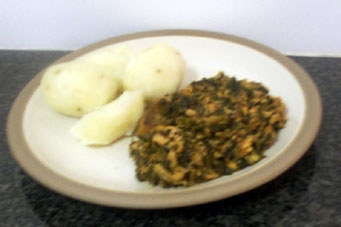 |
Ampesi ne nkontumire
Nkontumire literally means spinach or greens. It is also used as the name of the stew (floe) illustrated above, composed of boiled then chopped or puréed greens, sauteed with onions, some tomatoes perhaps, oil and smoked fish. Chili peppers are used for some spice, varied by taste. In Pigeon English, this dish is often called "Palaba Sauce," the word "palaba" derived from "palaver" from the Portuguese era, meaning a discussion or a case to settle.
Preparing the soup
The soup to eat with fufu, is "complete" if it has some animal each from the sky, the earth and from water. See Three Souls. Chicken usually is OK for something from the sky. In rural areas, wild birds, such as toucan, are caught by young men and end up on the soup. Fish or fresh water prawns (crayfish), or something from the sea if available, serves for something from the water. The earth can provide something from the bush, such as snails, deer, or domestic animals such as sheep or goat. Vegetables almost always include tomatoes, onions and chilli. For stews, spinach is often used, and the crushed seeds of agushi, a melon related to watermelon, or black eyed peas. Smoked fish is popular in stews.
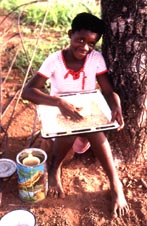 |
Cleaning Beans
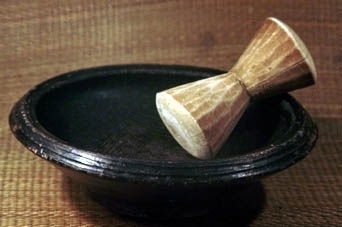 |
 |
Mpayewa | Used as a Blender to Puré Tomatoes
This bowl, called mpayewa, is made of clay, and its surface is blackened by wet leaves in the kiln. It has a serrated bottom so that when boiled vegetables can be ground into a smooth slush that can then be put into soup or added to stews. (Fufu is eaten only with soups, but other starch foods, boiled, fried or roasted, are eaten with stews).
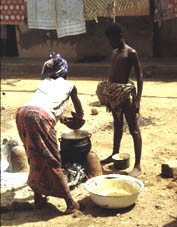 |
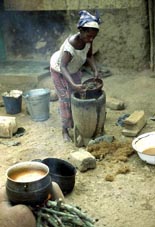 |
Palm Oil Preparation
Three types of soup (nkwan) can be described. The preferred soup is made with palm oil, abenkwan) not refined, including the solids as in freshly extracted from the kernels. Ground nut (peanut, goober) soup, nkatekwan, is made from roasted peanuts ground into a fine paste (like peanut butter). Light soup (nkrakra) does not have the heavy oil in it and is often fed to people who are ill. Onions, tomatoes and chilli peppers are common to all the soups. Perfect soup will have a representative meat from the three elements of the universe (See: Three Souls): from the land, the air and water. Chicken serves for that from the air. Snails from the rain forest are most popular from the earth, but goats or bush meat (deer or grass cutters) can be used. Fish can be from the local rivers or the Afram lake, but is more commonly brought from the ocean. Any of the meat can be fresh or smoked, but smoked is favoured.
Continued on Page Two . . . .
- Gender Hub
- Gender Introduction
- Gender Commensality ; Gender II
- Women I; Food
- Women II; Farming
- Women III (1): Cooking
- Women III (2): Cooking 2
- Women IV: Marketing
- Women V: Clay
- Men I: Wood
- Men II: Weaving
- Men III: Hunting
- Men IV: (1) Transport
- Men IV: (2) Transport
- Men and Women; (1) Oil Palm; Introduction
- Men and Women; (2) Oil Palm; Farming, Oil
- Men and Women; (3) Oil Palm; Wine Tapping
- Men and Women; (4) Oil Palm; Wine Marketting
- Men and Women; (5) Oil Palm; Other Products
- Men and Women; (1) Oil Palm; Conclusion